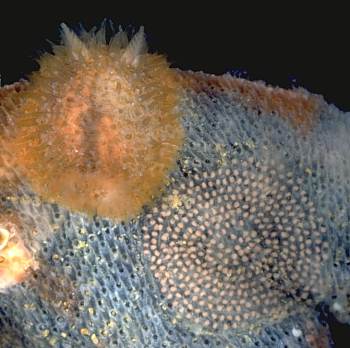
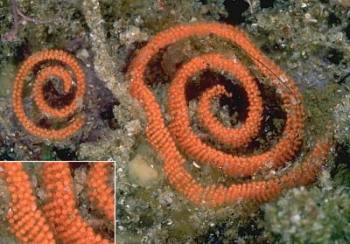
Nudibranch egg masses - the direction they spiral
PHOTO
Upper: Onchidoris depressa near Hobart, southern Tasmania, Australia, 14 Feb 1984. AM C141235. Lower: Rostanga arbutus Egg ribbons showing large direct-developing eggs. Coffs Harbour region, New South Wales, Australia. December 1990. AM C64554. Photos: Bill Rudman.
Many opisthobranch egg masses form a spiral ribbon, and of these, most seem to spiral in an anticlockwise direction [sinistral] - that is coiling in a anticlockwise direction from the centre. However some such as Melibe australis and Melibe engeli seem to be dextral, coiling clockwise from the centre.
As you will see in the attached messages there is some discussion about whether in the northern hemisphere they spiral anticlockwise and in the southern hemisphere clockwise. As I mention above there are certainly some species that have anticlockwise coiling egg ribbons but we have not enough information to say whether this is based on phylogenetic relationships or geography. Another complication is that some species start the egg spiral from the outside while the majority start from the centre. If a ribbon is started at the outside then it will look the reverse to what it actually is.
Authorship detailsRudman, W. B., 2004 (August 2) Nudibranch egg masses - the direction they spiral. [In] Sea Slug Forum. Australian Museum, Sydney. Available from http://www.seaslugforum.net/find/eggspir
Related messages
Egg spiralling
March 16, 2004
From: Gilles Matheron
Dear Sir.
For professional reasons (I'm working in show business!) I had to search informations about opisthobranchs, and more specifically Chromodoris annae ...
You mention, about egg coiling, that "Most opisthobranch egg masses seem to spiral in an anticlockwise direction [dextral] - that is coiling in a anticlockwise direction from the centre." [message: #9839]
May I suggest an error in your sentence... as "dextral" rather means "to the right". For instance the Italian language still use these words, with "destra" being "right side" and "sinistra" meaning "left side", respectively "clockwise" and "anti-clockwise".
I know, as you stated, Nudibranchs can be tricky sometimes, and they surely are.
Anyway, your site is a proof passions can be transmitted to non-specialist candid people, like myself. From now on I will keep myself aware of the Nudibranchs day-to-day life !
Sincerely yours.
Gilles Matheron,
Montpellier, France.
g.matheron@wanadoo.fr
Matheron, G., 2004 (Mar 16) Egg spiralling. [Message in] Sea Slug Forum. Australian Museum, Sydney. Available from http://www.seaslugforum.net/find/12447Dear Gilles,
Thanks for taking the time to let me know of this error. You are of course right. I must have prepared that answer late at night. To save confusion I have corrected my earlier message.
Although nothing to do with slugs, it is interesting to note that there has been a long-held belief in European culture that left-handedness is bad. In medieval times left-handed people were often given a bad time because they were thought to be touched by the devil and until a generation ago teachers were still attempting to force children to become right-handed. The English word 'sinister' meaning evil or untrustworthy is from the same Latin word.
Concerning Chromodoris annae, I am not sure if you found what you were looking for, but if it was about their eggs, they lay, like most chromodorids with black longitudinal lines, a flattened egg spiral, which spirals clockwise from the centre [dextrally].
Best wishes
Bill Rudman
Nudibranch eggs - direction of spiral
May 7, 2003
From: Asther M. Lau
Hello,
Just wondering which direction do most nudibranchs lay eggs. Clockwise or anti-clockwise?
Asther M. Lau
asther@scubadiveknit.com
Lau, E.M., 2003 (May 7) Nudibranch eggs - direction of spiral. [Message in] Sea Slug Forum. Australian Museum, Sydney. Available from http://www.seaslugforum.net/find/9839Dear Asther,
Have a look at the egg spiral page. You will find a number of relevant messages there and a number of links to other messages.
Most opisthobranch egg masses seem to spiral in an anticlockwise direction [sinistral] - that is coiling in a anticlockwise direction from the centre. However some such as Melibe australis and Melibe engeli seem to be dextral, coiling clockwise from the centre.
However you will see there is some discussion about whether in the northern hemisphere they spiral anticlockwise and in the southern hemisphere clockwise, but there is not a lot of evidence to support that idea. Another complication is whether the egg ribbon is started at the outside or in the centre. Usually the egg ribbon is started at the centre, but in a few animals the egg ribbon is started at the outside. If a ribbon is started at the outside then it will look the reverse to what it actually is. Nothing is simple I'm afraid.
Best wishes,
Bill Rudman
The direction of egg-mass spiralling
April 1, 2001
From: Yoshiaki J. Hirano
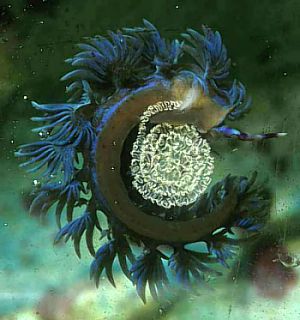
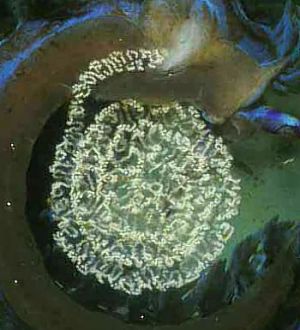
Dear Bill,
I really enjoy the Sea Slug Forum. Thank you very much for everyday effort.
Here is a photo showin the spawning of Pteraeolidia ianthina from Boso Peninsula, central Japan. I took this photo through the glass of aquarium tank. As you see, the animal spawned the egg mass circling counterclockwise. I strongly believe that the direction of spiralling is universal in different species or in different geographic area. I have an idea that the direction of spawn is closely related with the position of female genital aperture in nudibranchs. By spiralling counterclockwise they can touch the newly spawned mass effectively and can continuously press it with their foot. I think both activities are quite important for making neat spiral shape. If the direction were clockwise, both would have been very difficult. The important thing is opposite direction of egg ribbon spiraling against the genital aperture I think.
The very interesting photo of the "pseudodextral" spawn of Doridella obscura presented by Dr Irina Roginskaya reminded me of the egg mass of the littoral pulmonate limpets such as Siphonaria japonica. They always start spawning at the outside towarding the centre. However, I did not know there is the same way in nudibranchs! Yes, as you suggested, we have to go out and start watching animas more carefully.
Best wishes,
Yoshi
Yoshiaki J. Hirano
Kominato Marine Laboratory
MBRC, Chiba University
Japan
hiranoyj@earth2.s.chiba-u.ac.jp
Hirano, Y.J., 2001 (Apr 1) The direction of egg-mass spiralling. [Message in] Sea Slug Forum. Australian Museum, Sydney. Available from http://www.seaslugforum.net/find/4086Thanks Yoshi,
By coincidence, Mike Miller's beautiful photo of Hypselodoris bullocki spawning shows how the sole of the foot is used to attach the egg ribbon to the substrate.
I must look out the photos I have of Pteraeolidia spawning in the southern hemisphere to see whether they spiral the same way down here. Unfortunately I can't make out the direction of spiralling in Akos's photos from Sydney.
Best wishes,
Bill Rudman
Spiral egg ribbons
October 21, 2000
From: Irina Roginskaya
Dear Bill,
Can you inform me about the two beautiful photos of nudibranchs with egg masses, appeared not long ago in the Forum :
• 1. Chromodoris britoi Ortea & Perez,1983, from Italy;
• 2. Chromodoris clenchi Russell,1935, from Cuba.
Both spiral spawns are evidently dextral, especially the one from Naples. Are these photographs printed in normal way, or, by mistake, in reverse position?
Thanking you in advance.
Irina Roginskaya.
irina7@hotmail.com
Roginskaya, I., 2000 (Oct 21) Spiral egg ribbons. [Message in] Sea Slug Forum. Australian Museum, Sydney. Available from http://www.seaslugforum.net/find/3206Dear Irina,
Angel Valdes sent the scans. Hopefully he has the original photos to check from.
Bill Rudman
Thanks for spirals
August 5, 1999
From: Irina Roginskaya
Dear Bill,
Many thanks for publishing our message and especially for printing my poor "photograph" of D.obscura spawns.They are looking quite decent ! I couldn't contact with you via Hotmail, something happened with our mail, and so I dared to use the mail of the Slug Forum for this personal letter. This is the cause of my long delay. I am sorry. Good luck.
Irina.
irina7@hotmail.com
Dear Irina,
Just in case your still having email problems I'll reply through the Forum. I am happy to publish messages on any opisthobranch research. I am also happy to publish chatty messages such as this. It helps us all to keep in touch.
Best wishes,
Bill Rudman.
New research on egg coiling direction
July 30, 1999
From: I.S. Roginskaya & V.A. Grintsov
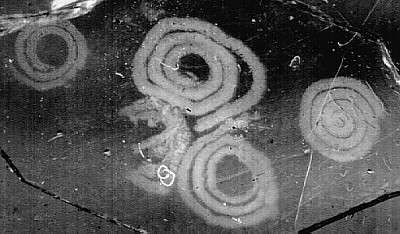
Dear Bill!
Do you remember last year I asked you about the direction of motion the nudibranchs are carried out while producing spiral egg-masses (March 5,1998 and (March 12,1998)? And your answer:
" However the direction in which the nudibranch coil is spiralled is the same throughout the world". (starting from the centre of the spiral and coiling to the left?)
Recently my colleague and co-author Vladimir Grintsov from Sevastopol (Ukraine, Black Sea) performed the interesting experimental studies of the egg-laying of an alien doridacean Doridella obscura Verrill 1870 (=Corambe batava Kerbert, 1886, according to C. Swennen and R. Dekker,1995). This small nudibranch, known as native to the Atlantic coast of North America, had been introduced accidentally to the Black Sea in the veliger stage via ships' ballast water discharge in the 1980s and 1990s.
The spiral egg masses of this unique northern hemisphere species long ago were indicated as dextral, i.e. clockwise directed (Franz, 1967; Perron and Turner,1977; Roginskaya and Grinsov, 1995). The recent data of V.Grintsov are remarkable: all the 14 specimens of D. obscura, he observed in the aquarium invariably started the egg-laying from the largest coil of the spiral, moving leftward towards the centre. And though the final flat spiral egg-ribbon looked like dextral, in fact the spirals were sinistral. The same mode of the direction of coiling while attaching the egg-mass to the substratum had already observed Costello (1938) in Hopkinsia rosacea from Monterey Bay, USA.
I have now in my possession a lot of "pseudodextral" spawns of D. obscura (sent by Dr. Grintsov), preserved in alkohol, some with the substratum. I am sending you a picture of 4 spawn, seen from above, attached to the piece of plastic. I am afraid, these images are useless for printing , but good as evidence. I am not skilled in microphotography, so I simply placed a small Petri dish (with the egg-ribbons on the plastic in water) on the desk-scan and tested different magnifications and backgrounds. The diameter of the right, (most dense) spiral is ~4mm.
Perhaps the alien Onchidoris depressa arrived to the southern hemisphere (Rudman, March 5,1998) also starts egg-laying from the outer whorl and its sinistral spirals are in fact dextral? In the Monograph of T. Gosliner (Nudibranchia of Southern Africa, 1987) two spiral egg ribbons of Corambe sp. are dextral (fig.11b). Maybe our Doridella once arrived with ships from the southern hemisphere and were forced to change their natural clockwise direction to a counterclockwise one, beginning from the largest whorl?
Best wishes.
Irina S.Roginskaya.
P.P.Shirshov Institute of Oceanology
Moscow, Russia.
irina7@hotmail.com
Vladimir A.Grintsov.
Institute of Biology of Southern Seas,
Sevastopol, Ukraine.
Dear Irina & Vladimir,
Firstly what a great way to 'photograph' the egg masses. And of course I remember your messages. I was hoping that you would find time to share more information with us.
Thanks for the interesting information on egg spiralling. It seems we have to go out and start watching animals actually laying down their egg ribbons. It s a bit of a problem if some are 'tricking' us by starting at the outside and spiralling to the centre! Another problem we should be aware of with published photos in popular books is the not unusual occurrence of printers reversing negatives during the layout and printing process. While in the case of shelled gastropods this mistake is very obvious, because the ahell coils in the wrong direction, it would not be so obvious with bilaterally symmetrical nudibranchs and their egg-spirals.
I for one will be hunting through my field notes and certainly in the future will be taking careful note of whether egg ribbons are being spiralled from the centre our or form the outside in. Perhaps we can say that if an egg spiral is incomplete in the centre (as in the three on the left in your 'photo') we can predict that the egg spiral was started at the outside. What do you think?
Anyone else's observations are welcome.
Bill Rudman.
Rudman, W.B., 1999 (Jul 30). Comment on New research on egg coiling direction by I.S. Roginskaya & V.A. Grintsov. [Message in] Sea Slug Forum. Australian Museum, Sydney. Available from http://www.seaslugforum.net/find/1128Re: Egg masses; the direction they spiral
March 12, 1998
From: Irina S.Roginskaya
Dear Bill!
Many thanks for your prompt answer. The direction of spiral spawns in southern hemisphere disturbs me for years (Roginskaya, 1987, 1991). This interest arose after discovering of the works of Risbec, 1928., Kenny, 1970., Bandel, 1976 and the photograph of eight clockwise directed spawn presented by Mr.T.E.Pitman of Rangiora in New Zealand Camera, (Oct.1972). Are you quite sure that your nudibranchs begin their Archimedean spiral formation from the centre and not from the largest whorl? Bandel, 1976, near equator, found both left- and right-coiled spawns. And his Favorinus branchialis could start both from the centre and from the largest whorl, sometimes even during the same egg-laying. Costello, 1938 observed the same reverse mode in Hopkinsia rosacea from Monterey Bay. Of course you can guess that I suspect Coriolis acceleration. My time is over.
Best wishes.
Irina S.Roginskaya.
Moscow, Russia
irina7@hotmail.com
Roginskaya I.S., 1998 (Mar 12) Re: Egg masses; the direction they spiral. [Message in] Sea Slug Forum. Australian Museum, Sydney. Available from http://www.seaslugforum.net/find/54Anyone out there with comments or observations?... Bill Rudman
Egg masses; the direction they spiral
March 5, 1998
From: Irina S.Roginskaya
Dear colleagues,
working with sea slugs in the Southern Hemisphere, can anybody inform me about the direction of coiling of spiral egg ribbons or egg strings of your nudibranchs? In the northern Hemisphere they are practically always counterclockwise directed.
Thank you.
Irina S.Roginskaya.
Moscow, Russia
irina7@hotmail.com
Roginskaya I.S., 1998 (Mar 5) Egg masses; the direction they spiral. [Message in] Sea Slug Forum. Australian Museum, Sydney. Available from http://www.seaslugforum.net/find/55This is an interesting question as their is some evidence to suggest that some floating siphonophores such as Bluebottles or Portugese man o'war (Physalia) and the related Velella, have their sails angled in the opposite direction in each hemisphere to catch the prevailing winds. However the direction in which the nudibranch egg coil is spiralled is the same throughout the world. One example I have illustrated above, Onchidoris depressa, is a good example as it is a north Atlantic species which has apparently arrived here in the southern hemisphere by hitching a ride on the bottom of a ship. If the position on the earth somehow affected the direction of spiralling you would expect it to change in Onchidoris but it doesn't. If anyone has photos of clockwise spiralling egg masses to prove me wrong please send them in.
Rudman, W.B., 1998 (Mar 5). Comment on Egg masses; the direction they spiral by Irina S.Roginskaya. [Message in] Sea Slug Forum. Australian Museum, Sydney. Available from http://www.seaslugforum.net/find/55